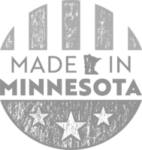FREQUENTLY ASKED QUESTIONS
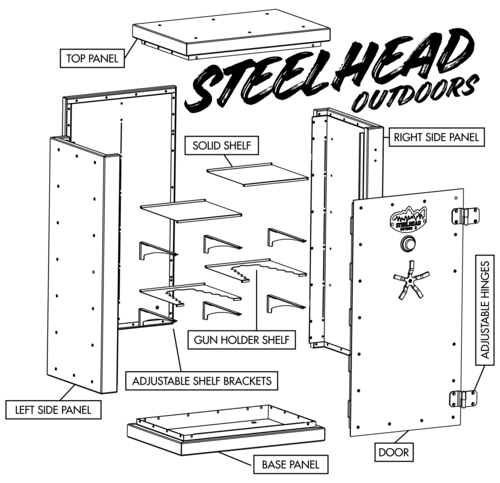
STEELHEAD OUTDOORS SAFES AND CABINETS ASSEMBLE ON SITE
Modular Gun Safes: The Ultimate Guide to Flexible and Customizable Firearm Storage
In the world of firearm storage, the modular gun safe is a game-changer. Traditional gun safes have their limitations, but modular gun safes offer a versatile and highly mobile alternative that caters to the diverse needs of gun enthusiasts, collectors, and responsible firearm owners. DIY Safe moving saves money, and adds freedom to your life to go where the next adventure takes you.
In this guide, we’ll delve into the world of modular gun safes, exploring what they are, their benefits, and why they are the ideal choice for those looking for a tailored firearm storage solution.
What Is a Modular Gun Safe?
A modular gun safe is a secure storage system made up of individual panels or components that can be easily assembled and disassembled. These components are constructed from steel and provide the same level of protection as traditional safes. The key advantage of modularity is the flexibility it offers in terms of size, configuration, and mobility. In the instance of modular safes, or “take-apart safes”, the major benefit is that the safe is assembled on location. Instead of bringing a large metal box home, you take home 6 separate panels and other associated components needed to assemble the safe yourself on location. The individual pieces are both much lighter and much smaller than the completed assembly, allowing two people to easily carry each panel into the home one piece at a time. After assembly the finished safe is a large steel box just like a traditional safe. If the joints are designed properly the safe should be as secure as a fully welded traditional safe. The ability to move the panels separately allows you to fit safes into places never possible before. If you’ve ever tried moving a gun safe, you know its no easy task! Modular safes avoid the expense of hiring a moving company, allow you the flexibility to easily disassemble your safe and take it with you when you move, and allow you the ability to put your safe in locations you never thought possible. The best security you can have is a safe that is in a discrete location.
The Benefits of Modular Gun Safes
- Easy Transportation and Installation: Traditional safes can be cumbersome and challenging to move. Modular gun safes, on the other hand, can be transported in smaller, more manageable pieces. Assembly typically requires minimal tools and can be done without professional assistance, reducing costs and hassle.
- Security: Security is a top priority for firearm owners, and modular gun safes do not compromise in this regard. Just like their heavier, bulkier one-piece brethren, they are constructed with thick steel, robust locking mechanisms, and have fire-resistant properties.
- Custom Accessories: Customize your safe with additional accessories such as shelves, racks, and door organizers to optimize storage space and keep your firearms organized and accessible.
- Ideal for Renters and Limited Spaces: Modular gun safes can be installed without permanent modifications to your living space, making them suitable for renters or those with limited space.
Why Choose a Modular Gun Safe?
- Mobility: The main reason to choose a modular gun safe is because it’s the only fireproof safe that can move with you. The average person moves seven times in their life, so when you buy this full size safe, you can take it apart and move it with you, without asking professionals to do it for you.
- Safety and Security: Modular gun safes are just as safe and secure as their one-piece counterparts. Modular safes have the same locking mechanisms, mechanical or electronic, and built with the same thickness of steel. All assembly parts are on the inside of the safe and the hardware is high strength steel with overlapping seams for increased strength.
- Versatility for All Firearm Owners: Whether you need a safe to hold a few firearms with ammo or storage for that family collection: modular safes can be as big or little as you need them while not being tied down to being left behind when you move homes. They come with all the same accessories to hang on the doors or shelves inside, keeping all of your firearms and extras safe, secure and protected from fire.
Modular gun safes are a revolution in firearm storage, offering unmatched mobility, security, and versatility. Whether you’re a gun enthusiast with a growing collection or a responsible firearm owner with unique storage requirements, a modular gun safe can be the ideal choice. Don’t compromise on your firearm security – choose modularity and tailor your gun safe to your specific needs today.
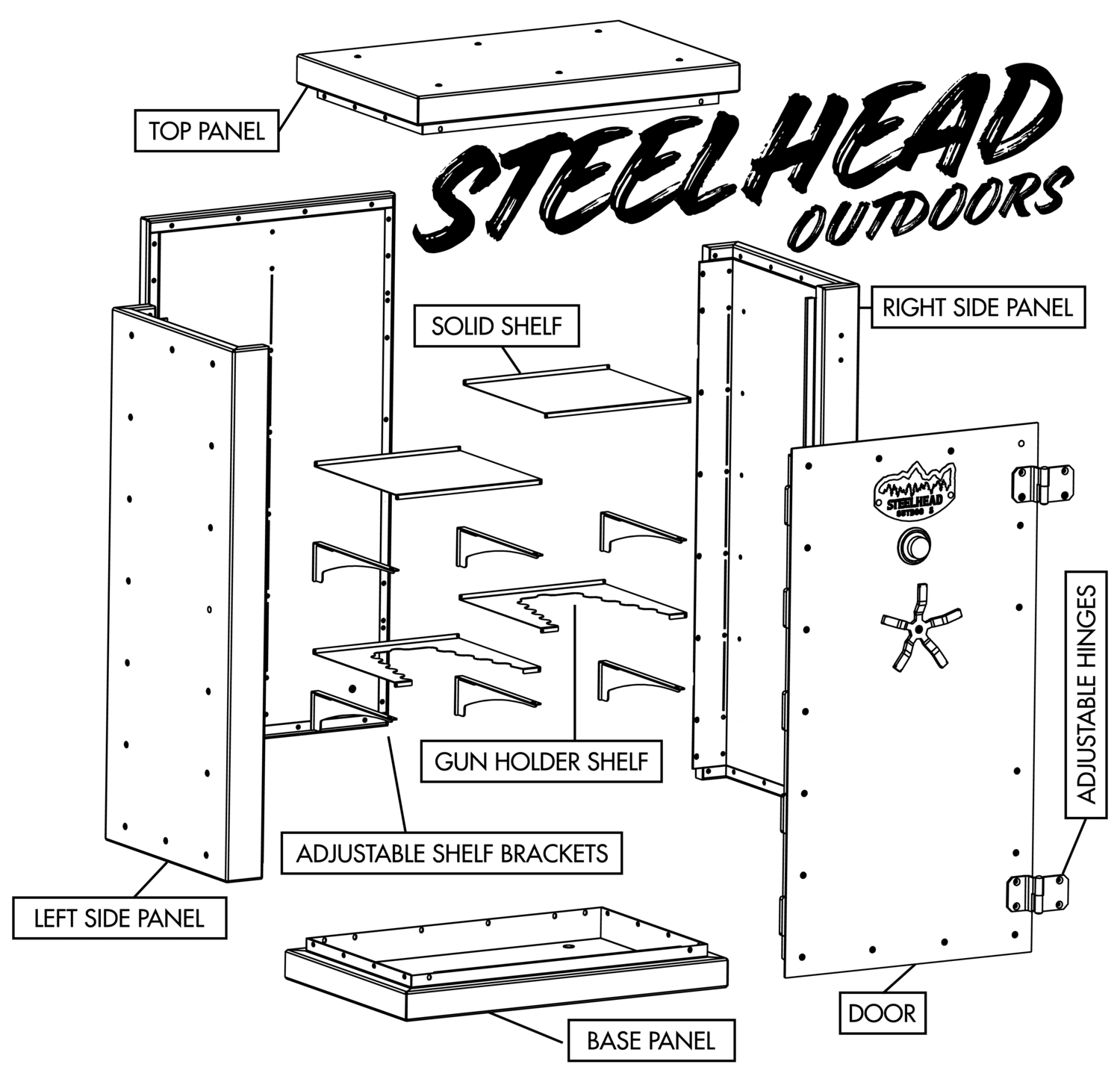
The Benefits of a Gun Safe (And the Benefits of a Modular Gun Safe)
There are many benefits of owning a gun safe and even more benefits of owning a modular gun safe. There are gun safes available to fit any budget – and any home situation.
- Protect Firearms from Unauthorized Use
Unauthorized use of firearms is the biggest reason many look to buy a gun safe. Unauthorized use can be:
- Theft – Safes help ensure firearms remain untouched in the event of a break in and keep them away from those who may want to use them in a dangerous manner.
- House Visitors – from babysitters, friends and neighbors; people can be curious and may pick up a firearm to look at more closely, hold it or potentially try to use it without understanding the consequences.
- Children – parents’ first priority should the safety and security of their children, which is why prohibiting them from accessing your firearms is paramount. Locking up firearms in a gun safe with either a mechanical or electronic lock is the best way to achieve this. Steelhead Outdoors offers both mechanical and electronic locks. The electronic locks are S&G Titan Direct Drive.
Bottom line: a gun safe not only keeps the firearm secure but also reduces chances of children, or any other house member, gaining access to firearms.
- Keep Everything Hidden Away
Yes, everything is technically “hidden away” if it is inside of a gun safe. But where is the safe, itself? Where is it seen? Steelhead Outdoors recommends not storing a gun safe in a garage. A garage is one of the first places a burglar is going to gain access to a home. Not to mention every time garage door opens and closes, neighbors can see the safe. Garages also prevent a higher fire risk than inside the home. Experts recommend not to put safes in a place where it can be easily seen, like the garage, or display it as a showpiece. A safe means there are valuables. Keep it hidden away. Steelhead Outdoors can work closely with customers to create a customized safe to meet customers’ specific size needs, as well as providing custom color options.
- Protect Investments
A firearm collection could be one of the most valuable items stored at home. Coveted, collectible firearms and family heirloom firearms may mean more than just their dollar value. And although gun safes are made for storing guns, other valuables, like jewelry, can be stored as well to keep them safe. Keeping expensive possessions and important documents in a gun safe ensures its safety even when a house is vulnerable to thefts. Customized options are available for Steelhead Outdoors Modular Gun Safes. Steelhead Outdoors can configure the inside of a new gun safe to work for each owner.
The majority of break ins are “smash and grab” affairs, so it is important to keep valuables out of sight and locked up, no matter the budget. Increases in budget often come with added security, added convenience, or both. In the event of a break in, a safe will often pay for itself by minimizing loss. No safe is theft-proof, but additional security features create additional difficulties for attackers and buy you valuable time. It is up to the individual to decide where the ratio of the cost-of-the-safe versus the cost-of-its-contents begins to make sense.
Additionally, an often-overlooked part of protecting investments is preventing moisture damage and corrosion. Traditional gun safes utilize standard drywall as the fire insulator. Drywall has trapped moisture that is boiled off in the case of a fire. It performs well in fire testing but causes some corrosion issues in everyday use. The trapped moisture is slowly released inside the safe, creating an environment with potential to cause damaging rust and corrosion to the contents of the safe. This is the primary reason dehumidifier use is so widespread inside gun safes. Steelhead Outdoors safes utilize a unique, patent-pending construction consisting of a two-stage insulation system. This system is comprised of a dry ceramic fiber insulation rated to 2300 degrees F, and an interior metal panel with a radiant heat reflecting coating on the backside. This insulation system does not trap any moisture, so it does not give off moisture in everyday use and does not fill the safe with steam in the event of a fire.
- Keep Things Orderly
A gun safe will allow the owner to keep contents tidy and in order. Not only will a gun safe keep firearms from knocking around one another and potentially damaging the metal, wood, and the mounted scopes, a well-organized gun safe allows for quick entry and exit, if needed.
- Comply with Child Access Prevention Laws
The majority of states have laws designed to prevent children from accessing firearms. The strongest laws impose criminal liability when a minor gains access to a negligently stored firearm. The weakest prohibit persons from directly providing a firearm to a minor. There are a wide range of laws that fall somewhere between these extremes, including laws that impose criminal liability for negligently stored firearms, but only where the child uses the firearm and causes death or serious injury. Weaker laws impose liability only in the event of reckless, knowing or intentional conduct by the adult. States also differ on the definition of “minor” for purposes of preventing access to firearms by children.
- Meet Insurance Company Requirement
Some insurance companies have made it a requirement to store guns in a gun safe in order to be fully covered, especially if the firearm is of higher value. Learn more about firearm coverage details from a knowledgeable insurance agent and find out if a safe is required for coverage.
- Gain Potential Insurance Discount
Some insurance companies will provide a discount on your policy if a gun safe is used. The discount is offered because a gun safe ultimately decreases the chances a claim will be filed to replace firearms lost in a burglary. It’s smart to see if discounts are available. Steelhead Outdoors can work with owners to provide proof of purchase – and proof of Steelhead Outdoors being a quality safe.
- Protect from Natural Hazards/Disasters
Natural disasters and fires often happen without warning. If a fire does happen, a fire-rated gun safe can withstand intense heat for a specific amount of time before the heat enters the safe. This type of safe is often built with thicker steel walls and may come with special seals that expand when the temperature soars to seal the safe’s door and keep fire out.
Most safe companies will say their products come with a time and temperature rating, but there is no accepted industry standard to certify the safe for fire resistance. Because of this, manufacturers are left to self-certify their safes. Every manufacturer uses different testing methods, and every fire is different. Different places in the home are also more likely to burn hotter in the event of a fire. Examples of cooler places in the event of a fire are: exterior walls, basements and inside closets. Modular safes often fit better in these cooler spaces than traditional safes. Moisture trapping insulators perform better in fire testing but come with other drawbacks not found in dry insulation systems. Fire protection is very much like theft protection in that nothing is invincible, but more money usually buys more time.
- Make Long-term Investment
Steelhead Outdoors doesn’t make the least expensive safes available on the market, nor are they the most expensive. Steelhead Outdoors gun safes are Made in USA, which keeps jobs in America to produce a high-quality modular gun safe product. This is a long-term investment, which is why modular gun safes are a great option – so you can take it with you if you change residences. Modular safes can be disassembled into several pieces which makes it easier to move versus one heavy traditional safe. The safe is assembled with hardware only accessible from the inside of the safe, so that it can only be disassembled after the door is opened, preventing unauthorized persons from attempting disassembly.
A gun safe offers the best protection against unauthorized use, theft and fire. Store other valuables in the safe along with a firearm collection and be worry-free. Contact Steelhead Outdoors to learn more about its American-made modular gun safes. Custom gun safe options are available.
Our safes, along with most other safes, are available in several different configurations. The ideal configuration is determined by what you would like to put inside your safe. Most gun safes are stated for a “gun capacity”. These are sometimes overly optimistic, and even include statements that say some guns must be upside down to fit the stated number of guns in the safe. We don’t push any misleading gun capacity recommendations so we only offer our interior configurations in a stated gun capacity that we have tried out and photographed for proof. For example, our Nomad 26 is available in 6, 12, and 15 gun capacities. We have physically put our own guns in the safe in those capacities. Our gun capacities are rated with a combination of scoped rifles and unscoped rifles and shotguns. If you have large optics or extra accessories like bipods, the capacity may be slightly decreased. See below for the 15 gun interior with 15 actual guns inside it, no blue guns or Red Ryders needed. Our interior system is completely modular and interchangeable. The integrated flush fit shelving brackets allow a tool less changeover from any of the standard configurations, and we offer many custom accessories that slide directly into the flush rails.
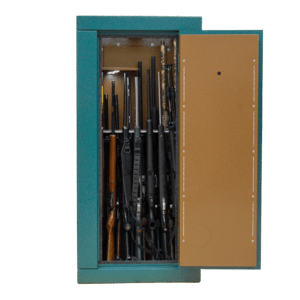
Our 15 gun safe holds 15 guns. The only disadvantage of the dual row gun storage option is that access to the back row of guns requires removal of most of the front guns.
We feel honesty is the best policy so there will be no unpleasant surprises with your Steelhead Outdoors Safe.
In all three models of Nomad safes, the multi-row option is called our Maximum Gun Storage option. This option gives up a little extra storage room as far as standard shelves and accessories are concerned, but will maximize the number of long guns for the given space. The Nomad 26 will hold 15 long guns outfitted like this, with the back row holding 7 guns and the front row holding 8 in an offset staggered fashion. The Nomad 32 will hold 19 with staggered rows of 10 and 9, fitting a third row is possible with minimal scopes, but not likely with a heavy dosage of scopes or AR pattern rifles. The Nomad 38 is deeper and wider and with a mix of guns will fit 3 rows. With a gun collection focused on AR pattern rifles or large scopes it is possible the 3rd row may not fit, but it often does. The back row would have 12 slots, the middle 11, and the front 12 in a similarly offset, staggered fashion.
Both safes are also available in a double horseshoe configuration. This configuration sacrifices gun capacity, but it is much easier to get access to any given gun without taking multiple guns out of the safe first. The double horseshoe has 12 slots on a Nomad 26, 16 slots in a Nomad 32 and 20 slots in the Nomad 38.
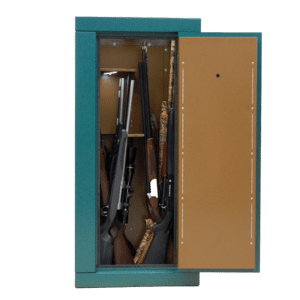
Our 12 gun double horseshoe interior option for the Nomad 26. This gives a good compromise between access and capacity, as less guns need to be shuffled around to get one from the back.
This configuration is the standard option on our safes and the most popular option.
We have also found that many people want to invest in a quality gun safe to hold a few guns along with other personal items or documents, so we offer a single horseshoe configuration with several extra shelves. This configuration will have 6 slots on a Nomad 26, 8 slots on the Nomad 32 and 10 slots on a Nomad 38. This is simply a single horseshoe version above.
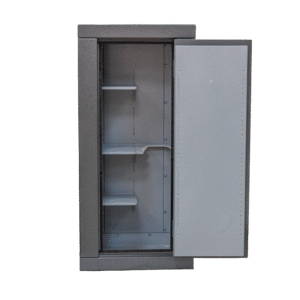
The lower gun capacity options provide more options for storage of other items.
Since the shelving bracket system is so versatile we can easily make custom accessories, racks or shelves that can be easily installed in your safe.
Whether you want to store your gun collection, want to keep your hunting rifles safe, or want to keep grandpa’s old side by side and grandma’s jewelry out of harms way, a Nomad 26, Nomad 32 or Nomad 38 can be customized to suit your needs. Best of all, it is finally a logistical possibility to take your safe to your next home. Since they are built to last, you can pass it down just like grandpa did his side by side.
Often times people ask us “What about those external hinges, aren’t they less secure? Actually, yours bolt on, couldn’t someone simply unbolt the hinges and take the door off?
This is a great question! Often times manufacturers will use the number of “active” locking bolts or bars as a selling point. The truth is that there is a much more elegant solution that has been used on many bank safes and vaults for decades. This solution is a dead bar on the inside of the safe. The natural swinging motion of the door on it’s hinge allows for geometry of a non moving portion of the door to naturally swing in behind the door jamb and lock itself into the safe. If you’ve assembled a Steelhead Outdoors modular safe, or watched our assembly videos, it illustrates the approximately 30 angle at which the door must be at to get the dead bar in behind the door jambs. In short, even with the hinges removed, the door cannot be removed unless the metal is compromised or the lock mechanism is opened.
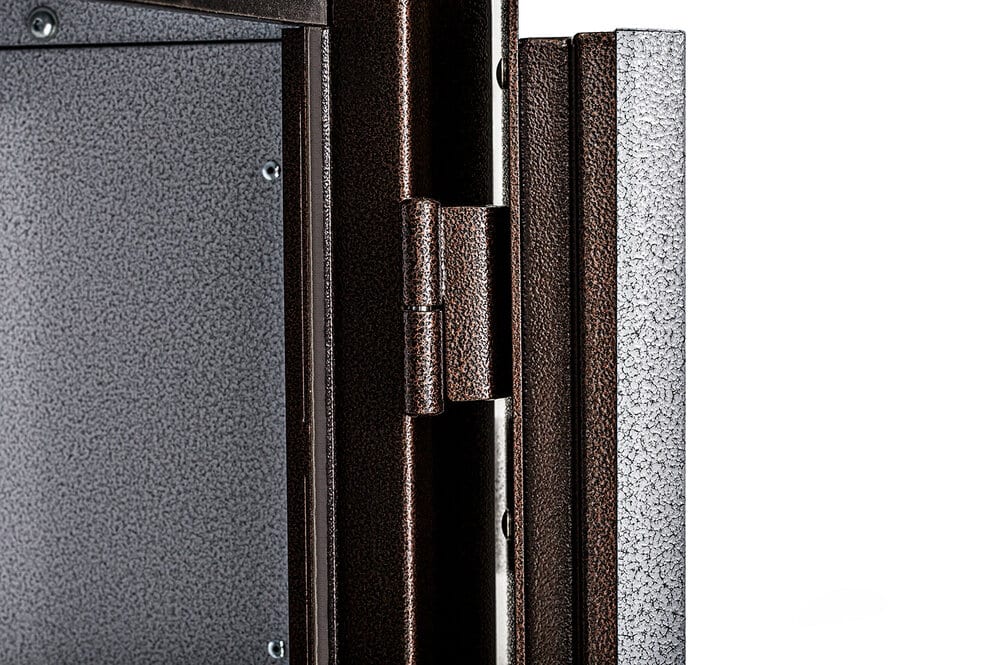
The full length dead bar swings in behind the reinforced door jamb when the door is closed, providing 100% contact area and creating a secure safe even with the hinges removed.
“But why are the hinges removable?”
Most safe manufacturers that offer external hinges will tell you the benefits of them: the door can open a full 180 degrees to grant better access to the safe and no fire insulation material needs to be removed in order to accommodate the internal hinges. We took it a step further and made our hinges removable. Since the safe ships to you in six pieces, the customer is responsible for installing the door. With the hinges being a bolt on design, the door needs to be swung into place by hand at a 30 degree angle, then closed into place and locked into position. After that, the hinges fastened on. The removable aspect of the hinge avoids the step of lifting the door 4 inches higher off the ground and trying to line up the hinges. Tighter fitting hinges offer less sag and smoother operation, but become difficult to align and install while trying to hold an 85-150 lb door in the air. The removable design allowed us to incorporate an ultra-precise hinge to eliminate any excess play. Our hinge pins are precision ground and hardened. They fit into a greased bronze bushing for exceptionally smooth operation and incredibly long life. The clearance between the hinge pin and bushing is less than 0.001” (one thousandth of an inch!) All of this combines to create a safe that assembles easy, swings smoothly, and is incredibly secure.
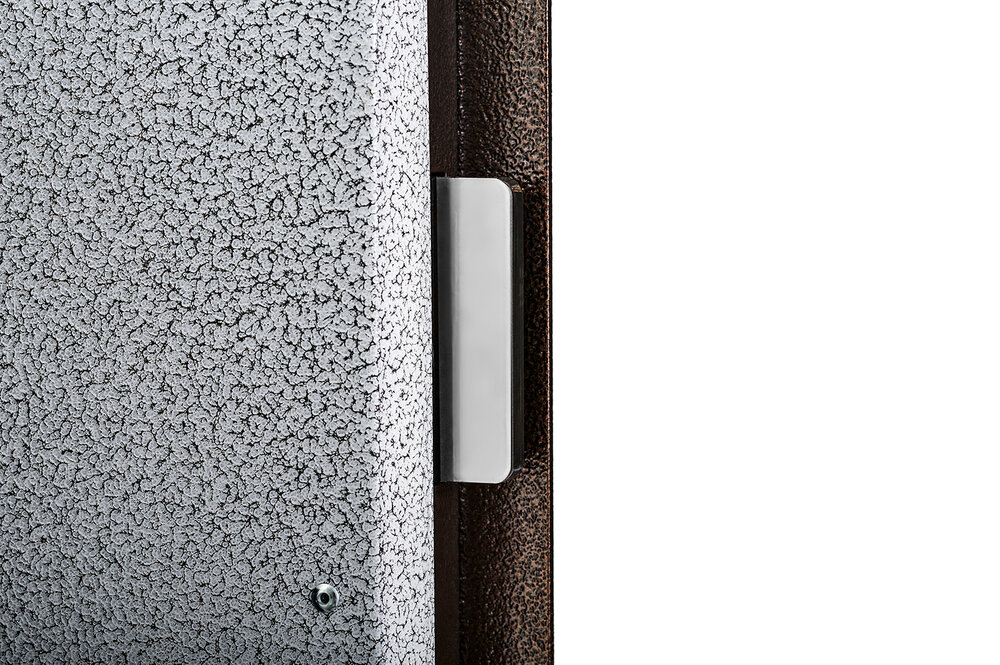
The 1/2 inch thick locking plates prevent the door from opening, keeping the safe locked up securely.
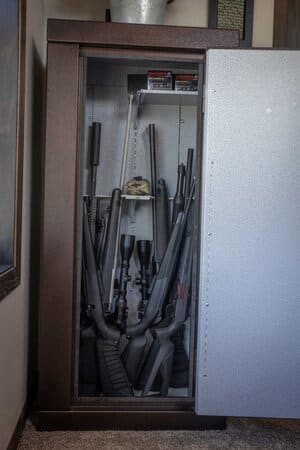
As a responsible gun owner, you want to ensure you are following the local, state and federal regulations for possessing, and storing firearms. Steelhead Outdoors recommends storing unloaded firearms securely locked away in a high- quality gun safe.
But perhaps you don’t have children at home, or you think unsafe/unlawful usage of your firearms “will never happen to me.” But it can happen. Juveniles could visit your home for an event or family gathering and suddenly stray to where you store your firearms. Or someone visiting your home to help with a task is curious and begins unauthorized handling of your guns. For this reason, several states and municipalities have passed what are known as “safe storage” laws. While safe storage laws vary by location, they generally refer to regulations requiring gun owners to store their weapons unloaded, in locked containers, or disable them with trigger locks to prevent tragedies and save lives.
What are the Federal and State Laws for Safe Gun Storage?
Though federal law has required federal firearms licensees to sell every handgun with a secure gun storage or safety device since 2005, surveys have discovered not all buyers use these mechanisms at home or in their vehicles, and federal law does not require them to do so. Therefore, lawmaking and enforcement has historically fallen to the states.
As of now, only a few states actually legislate safe storage of firearms with locking devices. Massachusetts requires all guns are locked or safely stored at all times and in all circumstances when they are not in use.* Connecticut recently updated its safe storage law to require gun owners in homes with children to unload their firearms and store them in locked containers.** Other states, like California and New York, have laws on the books that require safe storage of firearms under certain circumstances – for instance, if someone living in the home is a prohibited purchaser under state or federal law.
However, more states are looking into safe gun storage laws. Oregon is one, and Colorado just passed their “Safe Storage of Firearms” bill that will make unlawful storage of a firearm a class 2 misdemeanor.
Don’t just look to the state level when seeking information on gun storage laws. Municipalities can also enact regulations. For example, even though California does not require owners to safely store every firearm in their home, San Francisco requires owners to store every handgun in their home in a locked container or disable it with a trigger lock (a plastic or metal device that fits over the gun’s trigger and trigger guard to prevent the gun from being fired) when in a residence. New York City and Albany also go above and beyond state law in this realm as well, requiring firearm owners to safely store or render inoperable a firearm outside of his or her immediate control. ***
There’s also another law in the books – the child access prevention (CAP) laws, which is designed to keep guns out of the hands of those who are most vulnerable to misusing them: children and teens. Some states will distinguish between households with and without children when determining what constitutes safe storage. Unlike general safe storage laws, which have only been adopted by a handful of states and municipalities, currently 27 states and the District of Columbia have enacted some form of child access prevention legislation to date.
And these CAP laws are all different across each state – some with heftier fines to pay if broken. We encourage you to review the CAP laws for your state.
For example, in Minnesota, it is against the law to store or leave a loaded firearm where a person knows, or should reasonably know, that a child under age 18 is likely to gain access to it. Violation of this law is a gross misdemeanor. Here’s more tips from the Minnesota Safety Council on gun storage:
- Always empty the ammunition from your firearm prior to storing.
- Use a barrel lock, trigger lock, cylinder lock or a locking firearm case, or keep your firearm in a locked gun safe.
- Store ammunition separately, in a locked container, away from the firearm, heat and moisture.
- Never throw ammunition in the trash. (This includes spent brass as well!)
- Carry the keys for the gun and ammunition containers with you at all times or keep them locked in a spot that only you know.
- Never store a gun under a mattress or pillow, or on top of a bedside table.
- To help ensure that your firearm does not end up in the hands of a criminal, don’t store it among valuables such as jewelry where it might be stolen.
If you are looking for a trigger lock, we recommend contacting your local Sheriff’s office, or reach out to Project Childsafe.
Gun Storage Laws Aside – Lock Up Your Firearms
While it may not be enacted into law for your municipality or state, it is highly recommended that you lock up your firearms, in a safe manner, no matter what. Steelhead Outdoors offers a variety of customized gun safe options for your home or business. A gun safe doesn’t have to be ugly or sit in the garage where it is easily viewed by neighbors. Steelhead Outdoors modular safes allow you to literally place your gun safe anywhere in the home or business. And the best part? You can take it with you wherever your adventures may move you.
*https://malegislature.gov/Laws/GeneralLaws/PartI/TitleXX/Chapter140/Section131L
** https://www.cga.ct.gov/2019/ACT/pa/pdf/2019PA-00005-R00HB-07218-PA.pdf
*** New York, N.Y. Admin. Code §§ 10-311, 10-312(a); Albany Munic. Code § 193-6.
This article morphed into a “how and why” of all things Steelhead Safe Design
Since a modular safe is such a unique answer to the question “Which Safe is Right for me?”, we had a hard time writing this article without taking a pretty in-depth dive into our design rationale behind most of the key features of our safes.
Is there a standard rating in the industry?
When it comes to safes, it is often a balancing act between important characteristics. There is only one universally recognized fire testing procedure for safes, UL 72. There are many UL 72 rated fire safes on the market, but not any readily available gun safes. Because of this, gun safe manufacturers are left to write their own test procedure and test internally or have an outside laboratory test to their test procedure. Because of this variability, nearly every manufacturer has a different rating system, and different test methods. There is often no way to compare apples to apples, and these manufacturer supplied ratings should be treated as guidelines. Because of this variability, customers are left with no way to compare apples to apples. Given all of this variability, we have chosen to provide our design rationale and test data, rather than giving our safes an official “fire rating”.
First, a little bit about traditional fire insulation systems:
There are two major insulators used in fire safes, gypsum board and concrete mixtures. Both of these insulators work by way of trapped moisture. During a fire the moisture that is trapped during the manufacturing process is boiled off while the temperature stalls at the boiling temperature of water. Because a phase change is happening the latent heat of vaporization is helping maintain the temperature (remember your chemistry class?) This phase change phenomenon works wonders keeping temperatures low during heat input, but it does not come without drawbacks.
Old school, real deal bank vault level safes:
The ideal safe construction, if cost, weight and mobility are not a concern, is a double wall safe with an airtight inner shell, a poured concrete liner and an additional outer shell. This allows the significant phase change energy to be harnessed without the potential for any moisture to be displaced into the safe. The inner liner keeps the contents dry while the trapped moisture in the concrete liner is boiled out of the safe through the outer shell and to the atmosphere. There are many safes on the market built this way, and if you can manage the cost, size and logistics of moving them, they are undoubtedly the best bet.
The most common compromise:
Since buying a safe is an exercise in weighing the costs and benefits, many people make the decision that the top tier protection offered from these safes isn’t worth the significant cost investment or the significant weight. This led manufacturers to find ways to maximize performance at lower price points. By far the most popular gun safe construction method is to weld an outer shell, line the shell with one or more layers of gypsum board (drywall), then glue carpeting to the gypsum board. This construction decreases cost significantly, and still keeps the benefit of the phase change energy, but introduces a problem of moisture management. The moisture that is trapped in the insulating gypsum board is slowly transferred to the air inside the safe through osmosis, hence the reason dehumidifiers are so prevalent inside gun safes. If your guns can be on a display rack in your air conditioned house or in a gun shop, why can’t they survive life inside a safe? Safe interiors can be damaging to guns because it is easy for the slow and steady release of moisture to build up over time and create very high levels of humidity, which accelerate rust and corrosion. If your safe is ever subjected to a fire, all of the moisture that is boiled off is now stuck inside the safe with your guns until it leaks out or the door is opened. Again, if mobility is of no concern and you have a moisture management plan, these can be great safes.
The mobility problem:
Did you know the average American moves more than 11 times in their lifetime? All of the safe types we have mentioned come with mobility concerns. Since they are very difficult to move, they often get put in a “high risk” place of the home when it comes to fire (think garage, or out in a very conspicuous place). What if a safe could easily be placed in a “cooler” place (in the event of a fire) such as a closet or a basement exterior wall. A closet would provide two additional layers of drywall than the space just outside the closet. An exterior wall would provide some of the protection we mentioned with the concrete filled safes. A further benefit of added mobility is the ability to put your safe in a less conspicuous place in your house or business. Nobody can attempt to break into your safe if they can’t find it! Flexibility of location can improve the total fire protection and security that is now a part of your entire firearm storage solution.
Our solution:
At the onset we wanted to design a safe that solved as many of these problems as possible. We set out to design a modular safe from the get go, and we also wanted it to be of double wall construction. We experimented with several different thicknesses of inner and outer metal, insulation types and construction methods. We built a safe with a 3/16” outer shell, a 14 gauge inner shell and filled the wall with cement, but we ended up with panels that were too heavy to be easily movable by 2 people. Since this was one of our primary goals, we went back to the drawing board. We finally settled on a 7 gauge plate door, a 12 gauge outer shell for the bottom, sides, back and top and a 20 gauge inner shell. We riveted the inside shell to make the unit serviceable, and to allow us to run both the interior and exterior panels down the powder coat line, giving a ton of customization options to our customers. We filled the space between the inner and outer shells with ceramic blanket. We chose this material for its extremely high heat rating (2300 degrees F), its relatively light weight, good insulation properties, and the fact that it does not contain any trapped moisture. This insulation material solves the weight and moisture management issues. We also designed the inner shell with a reflective coating facing the outside to help push radiant heat away. This patent pending construction provides a unitized panel construction that is insulated and assembled at our factory, so all that’s left for you to do is bolt the panels together and install your shelving. Watch our assembly video to see how easy it is. We added a dual action seal to the door, containing a cold smoke seal and a head activated expanding seal. We also incorporated as many security features as we could into our desired weight class, including a ball bearing drill plate, a secondary punch guard on the main locking actuator, a ‘cam-over-center direct drive’ mechanism, full 1/2 inch door jambs, 1/2 inch locking plates, a deep 1.25 inch door recess to minimize possible pry attacks, and high quality mechanical and electronic locks. After we balanced all of the key attributes and chose our line of compromise, it was time to begin testing.
Our fire test method:
We tested our safes in an independent facility, in an open flame furnace set to 1200 degrees F. We chose this test condition, because 1200 degrees seemed to be the most common testing temperature, and we felt an open flame furnace best simulated a real life fire. The safes had 5 temperature sensors in each safe at varying heights and were completely empty. We decided on an array of sensors because we thought that would best correlate to protection of all contents inside the safe. We chose an empty safe to test a ‘worst case scenario’, as any contents placed into the safe would add thermal mass, delay the temperature changes and increase the test time. All sensors stayed below 350 degrees for 30 minutes. After testing, there was no moisture inside the safe, no steam event took place, and the insulation looks like the day it was new. If the manufacturer is not specifying their test procedures, and simply putting a sticker on the safe with a time and temperature, there is no way to know what the sticker is actually signifying.
Everyone’s situation is different:
As discussed throughout this article, choosing a safe is about drawing your own line of compromise through all of the possibilities on the market. If your #1 intent is to maximize mobility, a very affordable and relatively low security gun locker is probably your best bet. For maximizing security, you should probably buy the absolute heaviest safe you can find. We can’t stress enough though, don’t wait to protect your firearms. As firearms owners it is our responsibility (morally, ethically and oftentimes legally) to keep our firearms out of the hands of those they don’t belong in. If a safe isn’t in your budget, most counties have free trigger locks. If you’re like we were when looking for a quality gun safe: looking for a safe you could move yourself, that would adapt to whatever your current (or next) living situation may throw at you, is built with high quality components to stand the test of time and has smart features to maximize the security and fire protection in it’s weight and price class – a modular safe just might be the ideal compromise for you.
The best safe for an apartment, condominium or small space is one that secures valuables, is easy to move and can fit exactly where you want it. The benefits to owning a safe vary from protecting your investments to keeping everything orderly. Additionally, some insurance companies offer a benefit or discount for having a safe. The discount is offered because a gun safe decreases the chances a claim will be filed to replace firearms lost in a burglary. It’s smart to see if discounts are available. Steelhead Outdoors can work with owners to provide proof of purchase – and proof of Steelhead Outdoors being a quality safe.
How to Buy a Safe for an Apartment or Condo
Buying the right safe while renting an apartment or dorm is trickier than buying a safe as a homeowner that may never have to move. There are plenty of small personal safes that are adaptable to apartment living, but many people choose to put off getting a gun safe until living in a larger space.
The reasons why many people don’t have a safe in their apartment or condominium for their long guns and firearms varies from lack of space, to not wanting to move a safe a second time when moving to another residence. Steelhead Outdoors created a modular gun safe that provides a reasonable option for apartment and condo dwellers. The Nomad 26 was designed specifically to fit within most closet dimensions. At 25.5 inches wide by 54 inches tall by 18 inches deep, it even fits under many permanent closet built-ins such as clothes hanger rods. With 52 inches of clear height, it still fits most long guns without a problem.
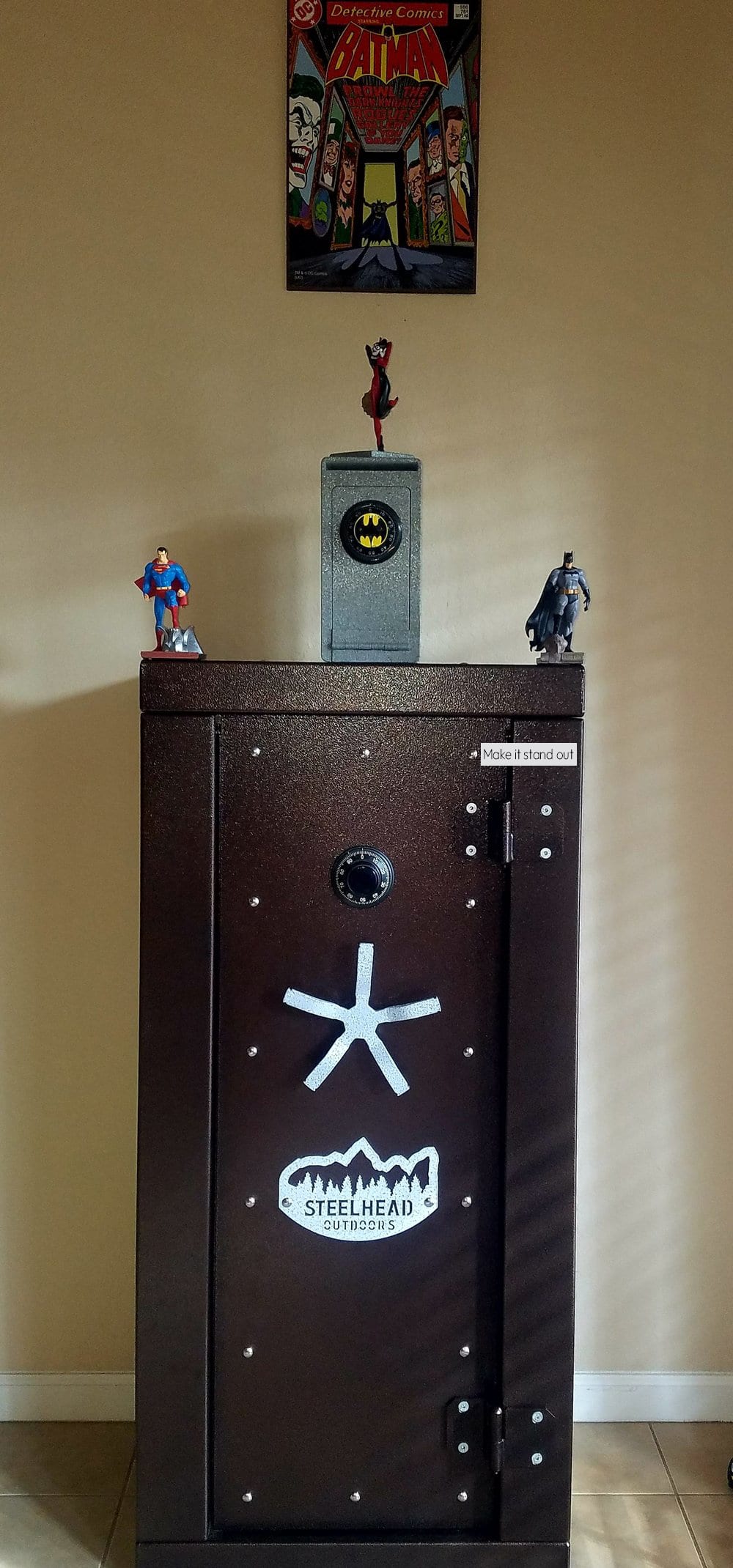
Our Nomad 26 is a great balance of portability and storage.
Benefits for a Modular Safe for Apartments or Condos
The benefits of a modular gun safe is truly seen in a condo or apartment building with multiple flights of stairs and no elevator. Each Nomad Series safe arrives in five boxes and can be delivered via freight to an apartment doorstep (if allowed), or it can be picked up locally in Minnesota. Carry those boxes to the spot where the safe will be located and being building the modular gun safe with our easy-to-follow instructions. Steelhead Outdoors provides the tools needed; no special tools are required. When moving, the safe can be disassembled and easily moved it from its current location to the moving van or truck and its new home.
Curious about shipping a safe to your apartment or condo? Ask us for a no-obligation quote here.
Many apartment or condominium dwellers tell us they love a modular gun safe because they have tricky stairs to navigate. Moving a traditional, one-piece, safe is not only cumbersome and heavy, but there is no way to easily navigate corners or 180 degree stairwells present in some apartment buildings. (Pivot!) We have even had customers take the panels up their residential elevator one at a time in the plain cardboard boxes.
How hard are the safes to put together?
What Makes a Good Gun Safe?
A good safe is made from strong, sturdy materials and reliably built to provide security for its contents.
The locking system plays a crucial role in securing and allowing access to a safe’s contents. An easy-to-open lock in a dire scenario can make the difference. Every Steelhead Outdoors safe is available with an EMP Resistant, UL Type 1, S&G Titan direct drive electronic keypad for no compromise access speed and reliability or a UL Group II, Big Red mechanical dial lock for battery-less dependability. Additionally, there is a slip clutch in the handle to protect entire lock mechanism from attacks.
Where Should I Put My Safe?
Steelhead Outdoors recommends placing a safe in an area that will not be seen by others. Note that bedrooms are often the first place that comes to mind for anyone looking for valuables. Try hiding it somewhere unconventional so it’ll be harder to find. Again, one of the benefits of a modular gun safe is that you can place it more easily in an inconspicuous area more readily that a traditional safe.
Conclusion
Our safes premium safes are customizable and built to last. Steelhead Outdoors are a great option for people who are on the move. Life is an adventure – take your safe with you.
Best Place to Put A Gun Safe At Home
We get a lot of questions about gun safe placement.
- Is okay to put gun safe in a garage?
- Should I put my gun safe in a closet?
- Can I put my gun safe in the basement?
We tell our Steelhead Outdoors customers that safe placement is a personal preference – there isn’t one ideal place. We’ve found that some customers are excited to show off their gun safe and gun collection while others opt for taking maximum security measures to conceal their safe. Here are some things everyone can consider when making a gun safe placement decision.
Placing a gun safe in a garage
It’s hard to hide a gun safe in a garage. Every time the garage door is opened you risk someone seeing that you are storing valuables in a safe. Why advertise to thieves that you have something worth stealing? Building a surround or closet to disguise the safe is a workaround.
Garage doors are also relatively easy to open or breach. A thief could use a tow strap to haul away a gun safe. Bolting the safe to the floor makes a thief work harder than they’d like.
Many flammable items are stored in a garage which increase the chance for fire or could increase the intensity of a fire. Cars, lawnmowers, paint thinner, cleaning chemicals and excess lumber are often stored in garages.
High humidity levels in garages can also harm items stored in a traditional gun safe. The threat of rust is a problem that most safe owners must handle.
Storing a gun safe in a bedroom closet
Concealing a gun safe in a closet makes the safe less visible and conspicuous which is a huge plus. Storing guns near your bedroom could provide you with easier access in an emergency situation. But realistically, is there enough extra room in a bedroom closet to stow a safe? Data also suggests that one of the first places burglars go to search for valuables is the master bedroom. If the bedroom isn’t located on the ground level, will the floor support the safe and its contents? Could the floor succumb to an intense fire?
Putting a gun safe in the basement
A basement can be a good place for stowing a gun safe. Keep nosey contractors, babysitters and housekeepers from knowing where valuables are stored by placing your safe in a workshop or another room that can be locked. A concrete slab reduces fire hazards underneath the safe. A basement is usually away from potential fire sources like a kitchen. Keep safes away from other potential fire sources like a fireplace. Humidity and water can damage gun safes, guns and other contents. If you reside in a flood A dehumidifier is necessary with most traditional gun safe designs. Steelhead Outdoors’ unique design and construction materials don’t trap moisture which reduces the need for a dehumidifier that takes up space within the safe and requires a power source. Thieves would have to work hard to haul a heavy safe up a staircase. Definitely consider housing your safe in the basement if you have one.
Steelhead modular gun safes can be assembled on site where you want to place your safe. The modular design allows for 1-2 people to disassemble the safe and move it to another location without requiring a specialty safe moving crew.
Steelhead Outdoors offers a variety of standard safe sizes and colors along with the opportunity to create a custom safe to fit your space and collection with a vast array of custom color finishes to blend in or stand out.
Contact Steelhead Outdoors if you want help determining which safe is right for you and the best place for a gun safe in your home.
There may be times when a gun may need to be temporarily stored in a vehicle. Research state laws where you live or travel as the laws vary about how and where a firearm can be temporarily stored in a car or truck. It’s not recommended to store a firearm in a vehicle but sometimes there’s no other viable option.
Reasons why to store guns in vehicles properly
- Avoid costly fines and penalties. While states have differing laws that include serious penalties and fines, it’s important that all gun owners properly secure firearms responsibly. In states with stricter gun laws, you could risk a felony.
- Car thefts are on the rise. News outlets routinely sound the alarm about the skyrocketing rise in car thefts. The National Insurance Crime Bureau states that 932,329 vehicles were reported stolen to law enforcement in 2021 in the US. That is a 6% increase over 2020 and a 17% increase since 2019. And there’s also a high incidence of gun theft even if the vehicle isn’t stolen.
- Don’t make it easy for thieves to take your handgun. You spent good money on your pistol. According to a 2023 FieldandStream.com article, a mid-priced handgun costs between $600-$1200. The FBI reports that on average at least one gun is stolen from a car every 15 minutes. If thieves break into your vehicle, don’t make it easy for them to take your gun. The Steelhead Large HD Pistol Lockbox is great American-made portable gun storage solution.
- Don’t let your gun be used against you or your family. The FBI reports that the most common source of stolen guns (41%) are cars parked at residences in driveways and outside homes. Think about that for a minute. Some firearms are stolen from unlocked vehicles. And according to the National Insurance Crime Bureau, an alarming 11% of vehicle thefts reported in 2021 were facilitated by keys or key fobs. Vehicle owners may leave their vehicles running attended to warm them up in winter months or cool them down in warmer months. “Puffing,” leaving a car running attended, is a common practice and thieves are ready to take advantage of this opportunity.
- Don’t let your gun be used in other crimes. Stolen guns are a major source of gun crime in the US. The US government reports that about 96% of those stolen firearms were stolen from cars and homes of everyday people. FBI data shows that gun thefts from cars are the largest source of stolen guns.
How to properly stow a pistol in a vehicle
- Know the particulars of state laws for where within the car or truck firearms can be stowed.
- Locked vehicles’ doors are not considered to be secure storage of firearms.
- The glove box and center console, even if they lock, are not secure gun storage locations. Thieves can quickly and easily pry these open.
- A lockable lock box or lockable gun case that can be securely affixed to the vehicle frame is the preferred storage of the National Shooting Sports Foundation. The Steelhead Large HD Pistol Lockbox can either be mounted or secured to the frame with a beefy cable. This Made in USA pistol box offers other high security features like 12-gauge steel construction and highly pick resistant key lock.
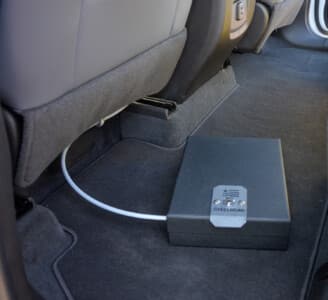
Steelhead Pistol Box secured with cable to seat
How to select a pistol lockbox to secure your gun in a vehicle
- Compare the thickness of the metal used in the pistol lockbox. The Steelhead Large HD Pistol Lockbox utilizes 12-gauge steel throughout which makes the lockbox more resistant to smashing, prying and hammering. This is more than 2x as thick as most key lock boxes. Massive ¼” hinges are staked, welded and feature an integrated pin guard to prevent punch attacks. Steelhead’s hinges are more than 2x as thick as most hinges. A 270-degree, welded reinforcement hoop is another security feature.
- Compare locks for pick-resistance. Steelhead’s key lock resists tampering attempts better than the competition. Other key locks have succumbed to coffee stir sticks and coffee straws. Steelhead’s high end key lock features a lock pick proof, multi-sidebar design with 6 billion key combinations and a hardened drill-resistant body with additional hard pins behind the face which is a major upgrade from tubular and wafer locks. A double shear lock mechanism proves increased pry support.
- Compare mounting options and cables. Steelhead offers four mounting holes on the base for anchoring. Bolting is the preferred method of securing a portable pistol box. Steelhead’s beefy cable that secures the lockbox to a vehicle is thicker than other cables which can be cut with a simple scissor. Steelhead’s 3’ long, 6,000 lb. rated, ¼” galvanized cable with 5/16” coating is made in USA.
- Compare sizes. Make sure the pistol box can accommodate your firearm, ammunition and spare magazines. Steelhead offers a large heavy duty pistol box weighing just over 11 lbs. Dimensions: 8.5” wide x 11” deep x 3” tall.
- Compare country of origin. Steelhead’s Large HD Pistol Lockbox is Made in USA, in Shakopee MN. If American-made is important to you, consider purchasing this high quality, well-designed pistol lockbox.
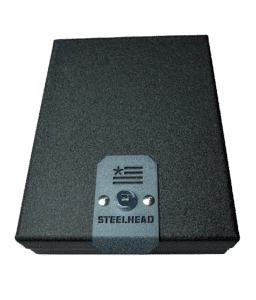
Pistol Box Exterior
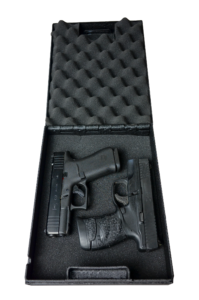
Pistol Box Interior
Watch Handgun Safe’s YouTube video review of the Steelhead Large HD Lockbox.
A pistol safe, a handgun safe or a pistol box, is a compact and secure storage container designed specifically for the secure storage of handguns. These safes are intended to provide quick and easy access to your pistol while keeping it out of unintended hands, such as children or potential thieves. Pistol safes come in various sizes, shapes, and locking mechanisms, but they all share the primary purpose of firearm security and accessibility.
Key features and characteristics of pistol safes include:
Security: Pistol safes are constructed from robust materials like steel and are designed to resist tampering and unauthorized access. They typically have strong locks and latches to keep the firearm securely locked inside.
Quick Access: Most pistol safes are engineered for rapid access to your handgun. They often use biometric fingerprint scanners, keypad combinations, or RFID (Radio-Frequency Identification) technology to allow the authorized user to open the safe swiftly in emergency situations.
Portability: Many pistol safes are compact and lightweight, making them suitable for various settings. Some models even have built-in handles for easy transportation.
Mounting Options: While some pistol safes are designed for portability, others can be permanently mounted to a surface, such as a nightstand or under a desk, for added security.
Capacity: Pistol safes are typically designed to store one or two handguns, but larger models are available for those with more extensive firearm collections.
Battery or Backup Power: Safes with electronic locking mechanisms usually have battery-powered systems, with some offering backup keys or external power options to ensure access even if the batteries die.
Tamper Alerts: Some pistol safes are equipped with features that provide alerts in case of tampering or unauthorized access attempts, enhancing security.
Fire Resistance: While not all pistol safes offer fire protection, some models come with fire-resistant properties to protect your firearms from damage in the event of a fire.
Pistol safes are a valuable addition to responsible firearm ownership. They help prevent accidents by keeping handguns out of reach of unauthorized users, including children, and deter
theft by providing secure storage. Their quick-access features are especially crucial in self-defense situations, allowing firearm owners to retrieve their pistols swiftly when needed while maintaining security when not in use.
When choosing a pistol safe, consider your specific needs, such as the size of your handgun, the level of security required, and whether you need a portable or mountable solution. Ultimately, a well-selected pistol safe enhances firearm safety and security while ensuring that you can access your handgun quickly when it matters most.
Firearms cabinets and firearms safes serve the common purpose of safely storing firearms and other valuable items, but they differ in terms of construction, security features, and intended use. There are budget-priced safes that are built with lighter gauge steel, but the industry term “gun safe” most often refers to the safes constructed with 12 gauge walls, UL listed safe locks, a strong locking mechanism, and a means of fire insulation. The industry term “gun cabinet” often refers to a single wall locker or cabinet with a traditional 3-point mechanism and most commonly a key lock. Here’s a comparison of the two:
Construction:
– Firearms cabinets are typically made of steel or metal, but they are less robust than safes. They often have thinner walls and less reinforcement, which makes them easier to move around the house or apartment and unfortunately to break into.
Steelhead Outdoors Scout modular gun cabinets or gun lockers are constructed with a single wall of 14 gauge steel and do not have any fire insulating layer. The simplified construction reduces cost, while the innovative design of the patent-pending 8 point vertical beam locking technology maximizes the security of the design.
– Traditional firearms safes are constructed with thicker steel walls and doors, and they often feature additional layers of fire-resistant materials. This construction makes them more secure against both theft and fire.
Steelhead Outdoors Nomad and Recon safes are constructed with 12 gauge outer walls and a 7 gauge plate door and an additional 20 gauge inner wall with ceramic blanket fire insulation between the layers.
Security Features:
– Firearms Cabinets may have basic locking mechanisms, such as key locks or combination locks. While these provide a degree of security, they are not as robust as the electronic or combination locks found on most safes.
Scout cabinets feature a high quality Sargent and Greenleaf lock used on many safes, and include a rack drive mechanism protected by a slip clutch.
– Traditional firearms safes often come with advanced locking mechanisms, which can include electronic locks with a keypad entry, biometric fingerprint scanners, and dual-lock systems. They include high quality locks built by companies like Sargent and Greenleaf and Securam. They offer higher security against unauthorized access.
Recon and Nomad safes include top of the line security features such as an internal AND an external relocker, a dual stage ball bearing and traditional hardplate sandwich, a direct drive double-locking, cam-over-center locking mechanism and a full length hinge-side dead bar.
Capacity:
– Firearms cabinets may have less interior space and fewer shelves or compartments. They are designed for basic storage and may not accommodate larger firearms or extensive collections.
Scout Cabinets feature in-line gun racks to maximize accessibility, and full-length steel shelves to maximize strength.
– Traditional firearms safes come in various sizes and configurations, offering more interior space and adjustable shelving to store not only firearms but also other valuable items, ammunition, documents, or important personal belongings.
Nomad and Recon safes feature 3 different standard layouts, and many customizable options including additional shelves, and MOLLE compatible gear panels for the door.
Fire Protection:
– Most firearms cabinets lack fire protection features, making the contents inside vulnerable to damage in the event of a fire.
Scout Gun Cabinets offer best-in-class value, security and mobility by eliminating the fire insulating layer found on traditional gun safes.
– Traditional firearms safes often include fire-resistant materials and insulation to protect the contents from heat and flames. They are more suitable for safeguarding firearms in case of a fire.
Steelhead Outdoors Recon and Nomad safes include a patented dual stage fire protection consisting of ceramic blanket insulating material and a reflective coated inner metal panel that creates a completely dry and non-moisture trapping interior.
Weight and Portability:
– Firearms cabinets are lighter and more portable, which may be suitable for those who need to move them occasionally or placing in upstairs rooms.
Steelhead Outdoors Scout Gun Cabinets ship in panels to be even more mobile than traditional gun cabinets.
– Traditional firearms safes are heavier, which enhances security but can make them less portable. They are generally meant to be installed in a fixed location.
Steelhead Outdoors Nomad and Recon modular safes ship in panels so that they can easily be moved and assembled by two people, breaking down one of the key barriers to traditional safe ownership.
Cost:
– Firearms cabinets are generally more affordable than traditional safes due to their simpler construction and fewer security features.
The Scout series incorporates several key security features of traditional safes like the hardplate and UL-listed Sargent and Greenleaf lock, while the patent-pending locking mechanism increases lock points over traditional cabinet designs.
– Traditional firearms safes come at a higher price point, reflecting their greater security, fire protection, and overall durability.
Nomad and Recon safes offer many top-of-the-line security features found on other high end safes along with a long list of exclusive features not found anywhere else. The Nomad and Recon safes are proud to stand as the only American made, Modular, Fire Insulated long-gun safes on the market.
Firearms cabinets are a more budget-friendly option for basic storage needs, while traditional firearms safes offer superior security, fire protection, and customization options. The choice between the two should depend on your specific requirements, budget, and the level of security and protection you need for your firearms and valuables.
Steelhead Lock Boxes
The importance of firearm safety cannot be overstated. Whether you are a seasoned gun enthusiast or a first-time gun owner, responsible firearm storage is a crucial aspect of gun ownership. Choosing the right firearm safe is a decision that should be taken seriously, as it not only safeguards your firearms from elements like moisture but also ensures they do not fall into the wrong hands, be it children or burglars. What follows are the essential factors to consider when picking out a firearm safe or cabinet.
Determine Your Needs and Budget
The first step in selecting the perfect firearm safe is to understand your specific needs and set a realistic budget. Take into account the number and types of firearms you own, as well as any additional valuables you may want to store. A larger collection will require a bigger safe with more storage capacity or multiple safes in the same or different locations. Your budget should be commensurate with your needs, as investing in a quality safe is an investment in safety and peace of mind.
Consider Security Features
The primary purpose of a firearm safe is to secure your guns. Therefore, the security features of the safe should be a top priority. Look for the following security features:
- Locking Mechanism: Safes come with various locking mechanisms, including electronic locks, combination locks, and biometric locks. Electronic locks offer quick access but require batteries, while combination locks are reliable but slower to open. Biometric locks use fingerprints for access, which can provide increased convenience and speed with increased battery usage as a possible downside.
- Steel Thickness: The thickness of the steel used in the safe’s construction is crucial. Thicker steel provides better protection against tampering and brute force attacks. This is a key consideration for firearm cabinets and lockers as well as fire insulated safes.
- Fire Rating: A firearm safe will have a fire rating whereas a gun cabinet/locker will not have a fire rating. Fire-resistant safes are rated based on the duration they can protect the contents in a fire. Since there isn’t a standard fire test that is certified by a governing body, most manufacturers perform these tests themselves. Well established American companies tend to have more robust testing and more straightforward claims.
- Locking Pins/Bolts/Plates and Hinges: Examine the locking bolts and hinges of the safe. A high-quality safe will have a robust locking mechanism and heavy duty hinges that are up to the task of supporting the heavy door. Concealed hinges provide security while only allowing the door to open 90 degrees. External hinges allow the door to open a full 180 degrees, and if properly fitted with deadbolts, an active locking mechanism or a jewelers lug can provide even more protection than concealed hinges.
- Re-locking Mechanism: Some safes feature a re-locking mechanism that activates if a thief attempts to tamper with the lock.
Size and Capacity
Consider both the physical size and internal capacity of the safe. Ensure that the safe will fit in your chosen location and that it has enough space to accommodate your firearms and accessories comfortably. Remember that it’s not just about your current collection; leave room for future acquisitions. When determining the size of your safe or cabinet, consider where you will place it. Steelhead modular safes and cabinets allow most customers to opt for a bigger or heavier safe than a traditional option since they are carried into position one panel at a time.
Placement and Accessibility
Think about where you intend to place the safe. It should be easily accessible to you but not to unauthorized individuals. A common recommendation is to install it in a closet, basement, or dedicated gun room. Ensure that you have enough space to accommodate the safe’s dimensions, and consider bolting it to the floor for added security. Especially gun cabinets or lockers as they are lighter weight and the leverage created by the door can make them unstable.
Durability and Construction
The quality of construction materials plays a significant role in the safe’s durability and resistance to break-ins. Look for safes made from thick, heavy-duty steel. There are many features that add extra durability: serviceable hinges, durable finishes, simplified locking mechanisms and high quality locks.
Portability
The average American moves seven times in their life, so depending on what life stage you are in, be sure to consider its weight and size. It used to be that safes designed for portability sacrificed some security features, this was the problem in which Steelhead Outdoors set out to solve with our innovative modular cabinets and safes.
Consider Extra Features
Depending on your preferences and budget, you might want to explore additional features such as interior lighting, adjustable shelving, and interior door organizers. These features can enhance the usability and organization of your safe.
Compliance with Local Laws
Ensure that the firearm safe you choose complies with local, state, and federal laws regarding firearm storage. Some jurisdictions have specific requirements for safe storage, so be aware of any legal obligations you must meet.
Installation and Maintenance
Once you’ve chosen a firearm safe, consider how it will be delivered, installed, and maintained. Safes can be heavy, and professional installation may be necessary. Additionally, regular maintenance, such as lubricating the locking mechanism, is crucial to ensure long-term reliability. Steelhead safes are designed with self lubricating bearings at every moving part inside the mechanism for a maintenance free safe.
Selecting the right firearm safe is a critical step in responsible gun ownership. It ensures the safety of your firearms, prevents unauthorized access, and protects your investment. Remember that a quality safe is an investment in your safety and the safety of those around you.
MORE INFO
Stay updated with the latest news from Steelhead Outdoors and get answers to commonly asked questions on products and services by visiting one of the links below.
